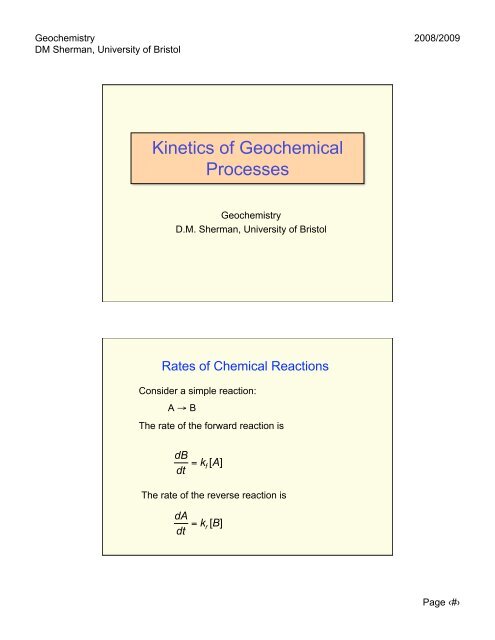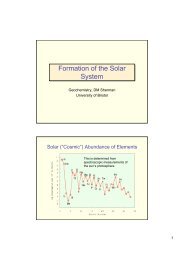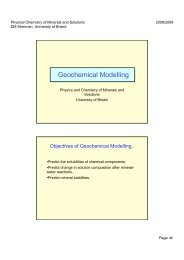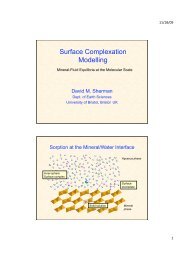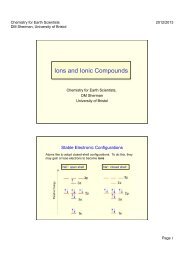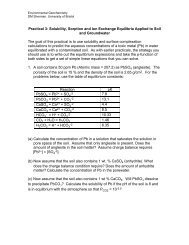Lecture Notes (PDF) - Aqueous and Environmental Geochemistry
Lecture Notes (PDF) - Aqueous and Environmental Geochemistry
Lecture Notes (PDF) - Aqueous and Environmental Geochemistry
Create successful ePaper yourself
Turn your PDF publications into a flip-book with our unique Google optimized e-Paper software.
<strong>Geochemistry</strong><br />
DM Sherman, University of Bristol<br />
2008/2009<br />
Kinetics of Geochemical<br />
Processes<br />
<strong>Geochemistry</strong><br />
D.M. Sherman, University of Bristol<br />
Rates of Chemical Reactions<br />
Consider a simple reaction:<br />
A → B<br />
The rate of the forward reaction is<br />
dB<br />
dt = k f [A]<br />
The rate of the reverse reaction is<br />
!<br />
dA<br />
dt = k r [B]<br />
!<br />
Page ‹#›
<strong>Geochemistry</strong><br />
DM Sherman, University of Bristol<br />
2008/2009<br />
Rates of Chemical Reactions<br />
At equilibrium, the rates are equal:<br />
dB<br />
dt = dA<br />
dt<br />
<strong>and</strong><br />
k f [A] = k r [B]<br />
!<br />
The equilibrium constant is<br />
K eq = [B]<br />
[A] = k f<br />
k r<br />
!<br />
Reaction Rate Laws In General<br />
In general, for an elementary reaction<br />
aA + bB → cC + dD<br />
the rate of the reaction (neglecting back reaction) is<br />
R = " 1 a<br />
d[A]<br />
dt<br />
= " 1 b<br />
d[B]<br />
dt<br />
= 1 c<br />
d[C]<br />
dt<br />
= 1 d<br />
d[D]<br />
dt<br />
= k f [A] a [B] b<br />
!<br />
where n = a + b is the order of the reaction.<br />
Page ‹#›
<strong>Geochemistry</strong><br />
DM Sherman, University of Bristol<br />
2008/2009<br />
Reaction Rate Laws In General<br />
First-order reactions (e.g., A → B):<br />
R = " d[A]<br />
dt<br />
= k f [A]<br />
Second-order reactions (e.g., 2A → B):<br />
!<br />
d[A]<br />
dt<br />
= k f [A] 2<br />
Zeroth-order reactions:<br />
!<br />
d[A]<br />
dt<br />
= k f<br />
!<br />
Integrating Rate laws..<br />
Suppose we have a simple first-order rate law for<br />
the transformation of A:<br />
d[A]<br />
dt<br />
= "k f<br />
[A]<br />
Multiply both sides by dt <strong>and</strong> rearranging gives..<br />
!<br />
dA = "k f<br />
[A]dt<br />
!<br />
d[A]<br />
[A]<br />
= "k f<br />
dt<br />
!<br />
Page ‹#›
<strong>Geochemistry</strong><br />
DM Sherman, University of Bristol<br />
2008/2009<br />
Integrating Rate laws (cont)..<br />
Now we integrate both sides. We have our initial<br />
condition that at t = 0, [A] = [A] 0 .<br />
A d[A] t<br />
" = #kf " dt<br />
[A] 0<br />
A 0<br />
!<br />
"<br />
ln [A] %<br />
$ ' = (k f<br />
t<br />
#[A] 0 &<br />
!<br />
[A] = [A] 0<br />
e "k f t<br />
!<br />
Half-Life<br />
The half-life of A is the time it takes for half of A<br />
to disappear (no reverse reaction):<br />
If<br />
A = A o<br />
e "k f t<br />
!<br />
Then when A = A 0 /2:<br />
t 1/ 2 = 0.693/ k f<br />
!<br />
Page ‹#›
<strong>Geochemistry</strong><br />
DM Sherman, University of Bristol<br />
2008/2009<br />
Half-Life<br />
Process<br />
Ion complexation<br />
Adsorption<br />
Gas dissolution<br />
Hydrolysis<br />
Precipitation/Dissolution<br />
Mineral Recrystallization<br />
Half-life<br />
<strong>Geochemistry</strong><br />
DM Sherman, University of Bristol<br />
2008/2009<br />
Activation Energies..<br />
Reactions with a high activation energy will show a<br />
strong temperature dependence of their rates. The<br />
measured activation energy can provide mechanistic<br />
clues..<br />
Process !G ‡ (kJ/mol)<br />
<strong>Aqueous</strong> Diffusion < 20<br />
Ion Adsorption 25<br />
Mineral Dissolution 40-80<br />
Solid State Diffusion 80-480<br />
Transition State Theory: Reaction Rate<br />
<strong>and</strong> Disequilibrium<br />
Rate net<br />
= Rate forward<br />
" Rate reverse<br />
For an elementary reaction<br />
!<br />
A → B<br />
Rate forward<br />
= k f<br />
[A] = [A] k BT<br />
h e"#G f ± / RT<br />
!<br />
Rate reverse<br />
= k r<br />
[B] = [B] k BT<br />
h e"#G r ± / RT<br />
!<br />
Page ‹#›
<strong>Geochemistry</strong><br />
DM Sherman, University of Bristol<br />
2008/2009<br />
Transition State Theory: Reaction Rate<br />
<strong>and</strong> Disequilibrium<br />
Since ΔG = ΔG ‡ f - ΔG‡ r<br />
Rate forward<br />
Rate reverse<br />
= e"#G f ± / RT<br />
e "#G r ± / RT<br />
/ RT<br />
= e"#G<br />
!<br />
!<br />
Rate net<br />
= Rate forward<br />
(1" e "#G / RT )<br />
Rate net<br />
= Rate forward<br />
(1" Q K )<br />
!<br />
Empirical Rate Laws..<br />
For most reactions, the elementary steps are not known.<br />
Empirical rate laws have been measured, however. For<br />
example the dissolution of gypsum:<br />
CaSO 4 .2H 2 O (gypsum) → Ca 2+ + SO 4<br />
2-<br />
+ 2H 2 O<br />
has the rate law (Langmuir <strong>and</strong> Melchior, 1985):<br />
d[Ca]<br />
dt<br />
= kA w (C s " C)<br />
With k = 2 x 10 -6 m/s, A w = wet surface area (m 2 )<br />
exposed<br />
!<br />
to a m 3 of water, <strong>and</strong> C s =15.5 mol/m 3 .<br />
Page ‹#›
<strong>Geochemistry</strong><br />
DM Sherman, University of Bristol<br />
2008/2009<br />
Mass-Transfer Limited Reactions<br />
•Reactions for which the elementary chemical steps<br />
are very fast will have rates determined by mass<br />
transfer. Mass transfer can be by diffusion or<br />
advection.<br />
•If diffusion is fast enough, the rate of the reaction will<br />
be advection controlled.<br />
Diffusion: Ficks First Law<br />
The flux (J, in moles/cm 2 -s) of a chemical species is<br />
given by the concentration gradient:<br />
J = "D #C<br />
#x<br />
!<br />
Diffusion constants<br />
of ions in water<br />
range from 10 -6 to<br />
10 -4 cm 2 /s.<br />
Page ‹#›
<strong>Geochemistry</strong><br />
DM Sherman, University of Bristol<br />
2008/2009<br />
Diffusion: Ficks Second Law<br />
The concentration as a function of t <strong>and</strong> x is found<br />
By solving the differential equation (Fick’s 2nd law):<br />
"C<br />
"t<br />
= D " 2 C<br />
"x 2<br />
With the appropriate boundary conditions to define<br />
the problem..<br />
!<br />
Diffusion<br />
For a simple constant-source problem, the boundary<br />
condition is C(0,t) = C 0. The solution to Fick’s 2nd Law is:<br />
C(x,t) = 1 2 C 0(1" erf<br />
x<br />
2 Dt )<br />
!<br />
Page ‹#›
<strong>Geochemistry</strong><br />
DM Sherman, University of Bristol<br />
2008/2009<br />
Diffusion<br />
A good approximation for any geometry is that<br />
C(x,t) " 1 4 C 0<br />
when x = Dt<br />
!<br />
Page ‹#›


